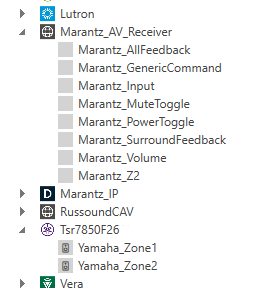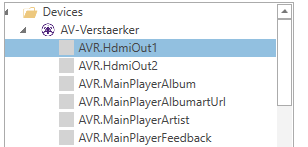May I add a suggestion. DirecTV feedback is some thing I would be very interested in too. One thing about there feedback is all time is done in “EPOC” linex time stamp “I believe that’s whats it called”. It would have a script to convert it from seconds to usable time. I am new and have not looked at writing a Plug-in but I think that may be the best route.
There’s already some DIRECTV feedback. The TvChannel capability has the current channel & program information.
Can you point me to info on how to display feedback from the DirecTV Device? Im still learning, LOL
The default TvDetails.xaml file has labels for the channel information. You can look at that file to see how it’s doing it. It’s really no different than binding any other attribute to a Label.
This is where you lose me. How does that apply to the DirecTV.
DIRECTV devices support the TvChannel capability. Everyone of those devices will have TvChannel attributes you can select when you want to bind them to a Label. Have you set up any Labels yet for other devices? It’s really no different than the process for those.
So I added a Label, then I go to the Text Field and try to Device Binding, from the drop down menu I scroll down to the DirecTV Area and see nothing for TvChannel.
Are you using the DIRECTV integration or is this IR? IR devices do not provide feedback. Can you post a couple screenshots so I can see exactly what you are seeing?
integrated, yes I know IR does not provide feedback. I found it but it started with BMNT, Bmnt.TvChannel.Number gives me the number. I would love to see feedback with times. Start, end time and progress into a show would be great.
Thanks again
The values in the dropdown always start with the device name you’ve assigned. You can change that if you want. Just select the device you want to rename in the Devices folder.
Thats the thing, every thing else starts with DirecTV. did not find under DirecTV.TVChannel.Number. Its started as BMNT where everything else started with DirecTV. Looked at all the labels for the device and they all start with DirecTV. I wonder if its because I have the IP device as well as I have a device labeled as “DirectvSetTopBox” under a Global Cache device for IR.
You’re looking at the device source & not the actual device objects. Expand the device source & then you will see BMNT.

I see it now, lots to learn. Like how much HomeRemote can do.
I’ve got two questions:
What’s the BMNT? I’ve looked in the devices and templates but don’t find anythign labled BMNT.
How does the TVDetails.axml file get used? Does a new page need to be created for each specific device linked to the device in the device list? I’m getting confused again…
I’ll follow up with another Yamaha question later, but to prep it… what exactly are the parts of this hierarchy called?
Device Folder
What’s the first level (e.g. Marantz_AV_Receiver, Tsr7850) are those devices or a device group?
Second level, for Marantz look to be TCPVariables, for Yamaha they are devices what are these called?

The yamaha sample I looked at has both the yamaha receiver and a virtual device:
These second level items are of type “YamahaReceiverVariable”

The virtual device second level items are of “VirtualDeviceVariable”

I’m trying to understand the labels so I can ask questions that make sense.
The question will basically be something to the effect of: were the receivers shown modified to toss out the default template behavior and replace with custom functionality which is used in some scripted manager?
If you add DirecTV IP to your devices, click to expand you will see one of the three items labeled with BMNT.
That was a device in Mike’s setup. His DIRECTV receiver was named BMNT. Everyone names their receivers differently. That’s read in from the receiver itself. There’s no telling what the name of your DIRECTV device is. You’ll probably have to check the about screen on your DIRECTV on screen menu.
That’s a template that can be used by the built-in Groups navigation, or custom DeviceBrowsers & PageBrowsers. No, a new page does not need to be created for each specific device. That’s the beauty of templating. You can build files that can be shared by many devices.
The 1st level is the integration source. The source is the controller that the app is communicating with. Think of it this way. Your Marantz receiver is the source & it’s zones are the sub-devices like Zone1, Zone2, & Zone3.
Get rid of those & Marantz & Yamaha devices. Those are the old integrations. Both of those have been obsolete for quite some time. You must have downloaded that from the old Google Group. There are newer integrations you should be using.
Delete everything you have. It is really best that you start with a HRP file that is current. Based on your screenshots it looks like you have a very old project file.
Do not start with the Designer. You no longer need the Designer to control your devices. Start with the apps & then export a backup for the Designer. The Settings page in the apps has a Backup button that can export a working up-to-date project that you can customize. That will really help you understand the process.
You will need to uninstall & reinstall the apps if you’ve already loaded your custom HRP.
I has suspected BMNT was a custom name but the talk almost sounded like that may not be correct. Thanks for the clarification and that makes sense.
I will follow your sage advice and start over. I really hoped to leverage a lot of the structure from JD’s project which I think is very well done. I’m happy to start with the app and work backwards. I’ll uninstall, reinstall, and start the discovery process. (I’m not looking forward to reconfiguring all my zwave devices…)
Nevermind, I see the need to enter the IP using Bill’s build from the app flow.
I also checked if you can address with the device name resolution DIRECTV-HR44-SN which was nice so I can avoid static IPs.
Was this the IP you were referring to? I do have that specified and it came in during the add discovery. I didn’t have to assign that one. Of course, we likely have different names for our receivers, mine here is bedroom although it’s not in my bedroom 
@Bill, so I figured out that the exported zip could be opened directly in the designer, but that wasn’t totally obvious because the open dialog filters on .hrp files so the zip is not visible but if you know the name you can type it out and it appears in the list of available matches.
I’m now confused on how to update the TVDetails.xaml file for the volume actions. I’ve copied the default TVDetails out from the templates, renamed the file, and updated the TVDetails template in the device so I think that’s good.
What isn’t clear is how to bind the volume ^v buttons to the receiver. The old way was to use an event trigger for on click with repeat to do a volume += 1, the new way has a binding to a device I can’t figure out: @Device.SupportedMediaCommand with the event of VolumeUp. The dataTrigger is set to update with a regular expression and value of VolumeUp.
Do I need to rework the actions to match the old way, or is there a newer way I should handle this? To add to my confusion over this, I’m now wondering if the video tutorials are current or do they also contain obsolete information like the older hrp files I was using previously.
You don’t need SupportedMediaCommands. That’s only on there so it will disable the controls for devices that do not support the specified command. If you are designing a page that you know supports VolumeUp, just set up a DataAction to write VolumeUp to MediaCommand attribute. You can forget about the extra SupportedMediaCommands stuff.

